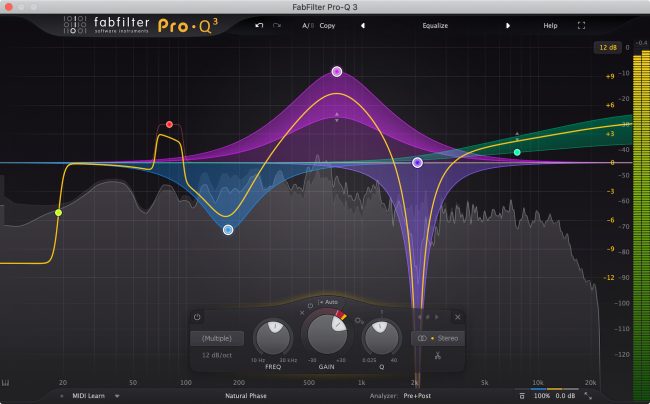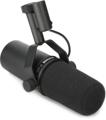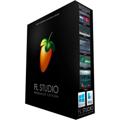
Recently, a friend of mine decided to get back into home recording after a 15-year hiatus. Previously, he had a Digidesign Mbox, a Blue Baby Bottle condenser mic, an inexpensive Washburn acoustic, a secondhand Danelectro guitar, a handful of drum samples, and a knack for making fun and often poignant indie-pop songs. But life happened, priorities shifted, and recording took a back seat — until just a few months ago.
Knowing that I’ve been steadfast in my gear and home-recording obsession, he reached out and asked for some advice on setting up a small recording space in his home. Nothing too fancy — an audio interface with a couple of inputs, a nice-sounding, affordable microphone, and a handful of plug-ins. After talking it out with him, we concluded that a Universal Audio Apollo Twin MKII DUO would be a good fit for his needs. While it’s more expensive than other compact interfaces, it comes with a fully functional DAW — the UAD LUNA Recording System — and a nice selection of UAD’s premium analog-hardware emulation plug-ins.
Fast-forward a week; he texted me that the Apollo Twin arrived, and he wanted to chat about what else he might need and to see if I could give him a refresher course on recording. For all intents and purposes, he was starting from scratch, and, during our conversations, I reflected on my experience buying my first audio interface in 2003, hooking it up, and thinking, “Okay . . . now what?”
For years, I recorded with a simple two-input interface, experimented with hundreds of plug-ins, tried out different gear that I either purchased myself or borrowed from friends, and did my best to make what has always been a modest home studio perform as well as possible. However, if I were to go back in time, I would approach things differently in terms of prioritizing my purchases and maximizing my small setup.
So, if you just bought your first audio interface and are wondering what you should get next, then here are some words of advice from a fellow home recordist.
The Big Question: What Kind of Music Do You Want to Make?
This may seem like an obvious question, but, when you’re starting out with recording, you may only have a nebulous idea about the kind of music you want to make. In my case, that’s been a persistent problem since I tend to style hop! While you don’t have to define your music according to some rigid genre guidelines, it is helpful to narrow down the types of music that really resonate with you and that you enjoy making. This has a practical purpose in that it can help guide your hardware and software purchasing decisions and can even determine the DAW that you choose. For instance, if you’re into EDM or ambient electronic, then you may want to consider Ableton Live, Reason, or Bitwig for your DAW. If you prefer recording live instruments, then Pro Tools and Cubase are solid choices. For hip-hop beat production, FL Studio has become something of a standard. And PreSonus Studio One is a well-rounded DAW appropriate for numerous genres and production styles.
Fortunately, most of the major DAWs have discounted or even free lite versions, so you can check them out and see if you like their workflows. But keep in mind that mastering any DAW takes a lot of practice and perseverance. So, once you’ve tried out a couple, commit to the one that felt the most enjoyable for at least several months. If, after that time, it still doesn’t seem like a good fit, then try a different DAW. For the first couple of years, and perhaps beyond, it’s wise to use subscription plans for your DAW rather than to purchase one outright.
At Sweetwater, we offer hours of free tutorials covering the most popular DAWs. Here are several to get you started!
Ableton Live
- 5 Tips for Getting Started with Ableton Live
- How to Use Ableton Live – Getting Started with Ableton Live
Avid Pro Tools
Image Line FL Studio
PreSonus Studio One
Steinberg Cubase
Universal Audio LUNA
Additional Resources
Getting to Know Your DAW, Exploring the Stock Plug-ins
Now that you’ve selected a DAW, give yourself some time to thoroughly explore its stock plug-ins. The desire to go on a plug-in shopping spree can be overwhelming. Trust me, I know — I’m a serial offender when it comes to snapping up the latest plug-in. However, you might be surprised at how much mileage you can get out of stock plug-ins. These days, the plug-ins that come bundled with your DAW, and in many cases with your interface, are usually powerful, professional-level processors.
Putting in the time up front to use the tools you have available in your DAW will give you a clearer perspective to identify the gaps in your plug-in collection so that you can make smart purchases of plug-ins you actually need and won’t simply clutter up your plug-in library. Plus, it will give you time to work on the fundamentals of recording and mixing without throwing in a bunch of additional variables.
As I alluded to earlier, I didn’t take this route after I bought my first interface. I loaded up on tons of plug-ins, grabbing whatever was on sale. In some regards, it was helpful because I was able to try out a bunch of different software and figure out my preferences. But, in practice, I now use a fraction of the plug-ins I’ve accumulated over the years, and the money I spent could have been more wisely invested in hardware, acoustic treatment, and other upstream gear that would have made a more significant impact on the quality of my recordings. Plus, the time it took to investigate new plug-in after new plug-in would have been better spent making music!
Trialing and Selecting Additional Plug-ins
Now, don’t mistake the advice of getting to know your stock plug-ins as some sort of dogmatic proclamation. As you’re scouring message boards and YouTube tutorials, you will no doubt encounter a contingent of gear ascetics — folks will try to sell you on the notion that, if you’re not able to make great-sounding recordings with just stock plug-ins and a $50 dollar microphone, you simply lack skills and talent. Personally, I find that a bit disingenuous. After all, some gear, both hardware and software, simply sounds better and, more importantly, has an ability to inspire.
That said, take advantage of free trials whenever possible. There’s a big difference between watching a plug-in review and using that plug-in yourself. Choosing the right tools to make your art is highly personal. Ask any guitarist, keyboard player, or instrumentalist, and they’ll tell you some instruments just feel right to them even though that instrument may feel totally wrong to the next person. The same thing applies to software, and the only way you can tell if you’ll vibe with a plug-in is by taking it for a test run.
Currently, I’m dedicated to many of UAD’s emulations of classic digital and analog gear, including their versions of the Universal Audio 1176, Teletronix LA-2A, AMS Neve RMX16 digital reverb, Lexicon 224 digital reverb, and the Dangerous Music BAX EQ. Plus, I can’t live without the FabFilter Pro-Q 3 EQ. But these are just my vibe. My recording buddies all have their favorites, and you are certain to find yours, too!
Embracing the Benefits and Limitations of Virtual Instruments
For a small home studio, virtual instruments can be a godsend, giving you access to a multitude of sounds that otherwise would be inaccessible. From acoustic drum kits to old-school synthesizers and full orchestral ensembles, if an instrument (or group of instruments) exists, then someone has made a software version of it.
Sampling and modeling software have become extremely sophisticated, and modern virtual instruments are shockingly realistic. Yet, there remains a difference between physical instruments and virtual instruments. If you expect a virtual instrument to be a perfect replication of its physical counterpart, then you are setting yourself up for disappointment.
Let me suggest a subtle shift in perspective. Treat virtual instruments as their own thing, not as a stand-in for physical instruments. Use them creatively and take advantage of the fact that they are unbound by the constraints inherent to physical instruments. In my workflow, I use a combination of real drums, sampled drums, drum machines, live guitar and bass, analog synths, software synths, and more. Accepting the limitations of both my physical and virtual gear has sparked a lot of creative work-arounds — such as re-amping virtual instruments, turning a monophonic analog synth into a polyphonic synth using a software sampler, and stacking programmed drums with live hats and cymbals to heighten realism.
Investing in Hardware, Microphones, and Other Gear
Let’s turn our attention to physical gear now, things like microphones, instruments, amplifiers, effects pedals, etc. From my home-studio experience, I’ve learned some important lessons related to buying real gear.
First, in less-than-ideal acoustic environments, dynamic microphones are your friend. While you can get away with a lot of production in the box and not have to worry about how your room sounds, once you mic something up, sonic deficiencies in your space will become evident. Condenser microphones, even inexpensive ones, are highly sensitive, meaning they’re going to pick up all the flutter echoes, traffic noise, and HVAC hum in your space. But a high-quality dynamic mic like the Shure SM7B or Beyerdynamic M 88 TG will give you a professional vocal sound while reducing background noise, and they’re versatile enough to use on numerous miking applications. In fact, in an acoustically poor environment, something like the Shure SM57 — the classic affordable stage and studio workhorse — is likely a better bet than an expensive large-diaphragm condenser mic. Will it sound hi-fi? No. But leaning into characterful lo-fi sounds in a small studio is a great strategy.
When it comes to the rest of your physical gear, get the absolute best that you can afford. Circling back to the gear ascetics, can you make great-sounding recordings with inexpensive gear? Yes, with enough time and effort, you can. However, keep in mind that one of the biggest differences between beginner-level gear and professional-quality gear is that pro gear gets you to the sound in your head way faster. The better the gear is, the less additional processing you’re going to have to do to make it sound good. And this applies to everything: microphones, guitars, amplifiers, effects processors, synthesizers, drums, and on and on. Investing in the best gear you can afford is ultimately going to give you back time in the studio — which is the most important creative commodity.
Final Thoughts
When you buy your first audio interface, you’re starting an incredibly exciting and challenging journey. As you learn more about recording through both education and practice, you’ll find that there is no formula for making great-sounding songs — and that is simultaneously liberating and exasperating! Like all things worth doing, becoming a skillful home recordist requires time, care, and patience. Some days will feel like absolute victories. Others will leave you beaten and frustrated. But there’s a reason that you and I both chose to buy a recording interface and pour hours into learning how to write, perform, produce, and mix. Because making music is magic, and, when it comes together, there’s nothing else like it!
Like you, Sweetwater’s Sales Engineers are passionate about recording. Want to chat about what gear might be right for your home studio? Give us a shout at (800) 222-4700.







